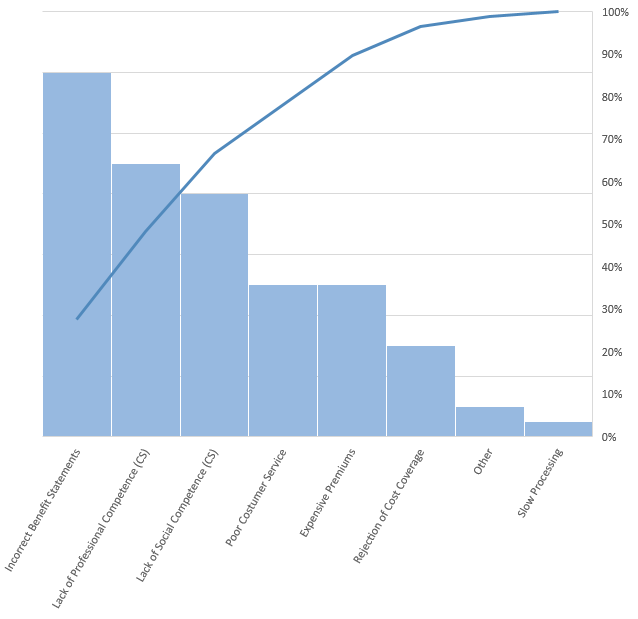80-20 Rule
(Pareto Principle)
Would you like to invest your money? Get in touch with an expert:
What is the 80-20 rule?
The 80-20 rule is also known as the Pareto principle. This life wisdom, also known as an aphorism, claims that 80 percent of the results are produced by only 20 percent of the inputs. It is therefore an important objective in business to identify and prioritize those inputs that are most likely to be productive. Focusing on these 20% will maximize the benefits. Nevertheless, the 80-20 rule is not a mathematical formula. The 80-20 rule has not been scientifically proven or disproven. In many instances, however, the rule is applicable. As an example, the performance results of salespeople in various organizations demonstrate the effectiveness of the 80-20 rule.
An organization may generate 80% of its revenue from 20% of its customers, for instance. As a result, it makes sense to place a particular emphasis on these 20% of clientele. The process involves identifying and analyzing these customers, as well as acquiring new customers with similar characteristics. Thus, the 80-20 rule refers to identifying a company's best resources and utilizing them efficiently in order to maximize its value. The passing of an examination is another example. Focusing on the most important aspects of the learning material is essential. These must be identified first. Due to time constraints, it is important to focus on the most important topics first before learning the remainder of the learning material. Because the principle is not a mathematical law, the 80-20 rule should not be interpreted as a ratio. Additionally, other factors should not be overlooked. The importance of the causes can vary over time, so it is important to keep this in mind at all times.
At the beginning of the 20th century, the 80-20 rule was first used in macroeconomics to describe the distribution of wealth in Italy. In 1906, the rule was introduced by economist Vilfredo Pareto, best known for his concept of Pareto efficiency. Pareto discovered the 80-20 rule when he found that 20% of the pea pods produced 80% of the peas. Finally, he showed that 80% of the wealth in Italy was owned by 20% of the population.
Joseph Juran discovered Pareto's research in 1937. Juran renamed the 80-20 rule "Pareto's Principle of Unequal Distribution". It was Juran who applied Pareto's principle to the business world in order to determine whether it could be applied to corporate problems. During his research, he observed that most production defects are attributable to a small percentage of factors. Accordingly, 80% of all problems are caused by only 20% of all defects. According to Juran's research, by focusing on fixing those 20% of the problems you can have a significant impact with very little effort.
Generally, the Pareto analysis consists of five steps:
- Identification of the problem
- Finding the possible causes of the problem
- Prioritizing the problems, weighting the priority of the problem according to the degree of negative impact on the company
- Organizing the problems into groups or categories (e.g., IT problem)
- Solve the problem (highest priority problems first)
Besides being used in business for decision making, Pareto analysis is also used in a variety of other fields. Based on the 80-20 rule, Pareto analysis suggests that 80% of the benefits of a project can be achieved with 20% of the effort. Or, conversely, that 80% of the problems can be attributed to 20% of the causes. Accordingly, this analysis can be used as a basis for prioritizing tasks. In Pareto analysis, each problem or benefit is given a score based on its impact on the business.
In a company, Pareto analyses are used to identify which problems have the most significant impact on different departments, organizations, or divisions. It is possible for companies to solve problems more efficiently by allocating resources to higher scoring problems based on the Pareto analysis. As a result, they are able to concentrate on problems that have a greater impact on the business. A Pareto analysis is usually performed by business leaders: The method relies on statistical analysis, such as a cause-and-effect analysis. Using the cause-and-effect analysis, it is possible to determine potential problems and their consequences.
The Pareto Chart
The Pareto chart is useful in determining the cumulative impact of a problem. It consists of both a bar graph and a line graph, in which the individual values are represented by bars in descending order and the cumulative sum by a line. In accordance with frequency and cumulative impact, the most important problems are presented in descending order.
Example of a Pareto Chart
Consider a health insurance company losing a large portion of its sales due to cancellations by many customers. The insurance company would like to analyze the reasons for cancellations in order to determine the cause of the cancellations. Therefore, the health insurance company analyzes the complaints received from customers. The following Pareto chart illustrates the number of complaints by type.
The most common complaint received from customers was that their benefit statements were incorrect. In addition, customers complained that the customer service lacked professional and social competence. The company received the fewest complaints about slow processing of benefit claims. Management has already been notified of a defect in the billing program that is responsible for the incorrect benefit statements. In response to the defect, many customers contacted customer service to voice their concerns. Sadly, the customer service department did not meet the expectations of the clientele. Dealing with the service billing error should be the first priority. In order to improve customer service, training should be provided. Furthermore, a strategy should be developed to attract new customers and win back lost customers.
Would you like to invest your money?
Speak to an expert.
Your first appointment is free of charge.




